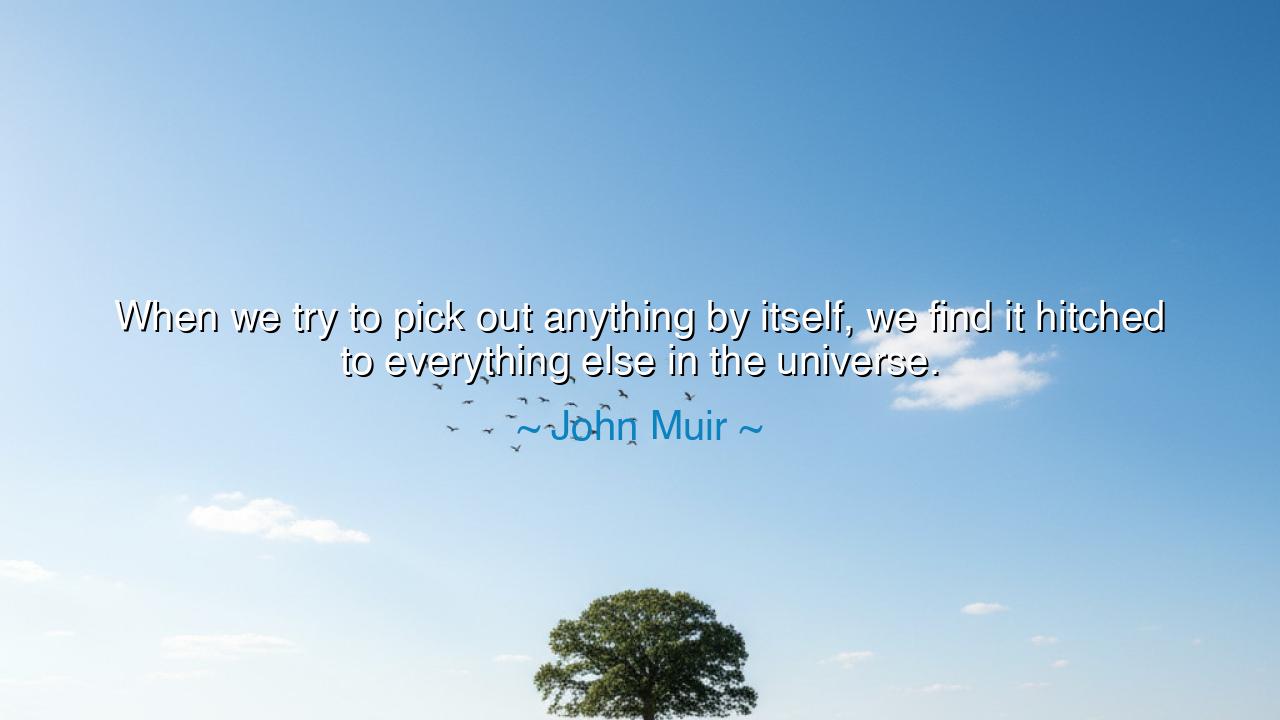
When we try to pick out anything by itself, we find it hitched to
When we try to pick out anything by itself, we find it hitched to everything else in the universe.






When John Muir wrote, “When we try to pick out anything by itself, we find it hitched to everything else in the universe,” he was not merely observing nature—he was unveiling a divine truth that humankind has too often forgotten. His words are the echo of the world’s oldest wisdom: that all life is bound together, that no creature, no stone, no stream, no breath exists in isolation. Muir, the great wanderer of the American wilderness and prophet of the Sierra Nevada, spoke as one who had listened long and deeply to the voice of the Earth. He understood that to touch even a single leaf is to disturb the entire forest, and that to wound the land is to wound ourselves. His insight transcends time, speaking as powerfully to the ancients as it does to those of our own age—an age that too often mistakes separation for strength.
Muir’s revelation was born from a lifetime spent in solitude among nature’s vast temples. In the late 19th century, as industry clawed its way across the American continent, he journeyed into the mountains, forests, and valleys—not to conquer, but to listen. In those wild places, he found no hierarchy, no boundaries—only unity. The rivers fed the trees, the trees sheltered the animals, the animals carried the seeds, and all were sustained by the sun and rain. It was there, walking through meadows heavy with dew, that he discovered what philosophers and mystics had long known: that the universe is not a machine of parts, but a living web of relationships. To pull on one strand is to feel the trembling of the whole.
Consider the story of the Yellowstone wolves, a tale that illustrates Muir’s eternal principle. When humans hunted the wolves to extinction, the land itself began to unravel. Deer and elk, no longer kept in balance, overgrazed the valleys, stripping young trees from the riverbanks. Without trees, the soil eroded, the rivers widened, and birds vanished. The landscape withered, and even the fish suffered. Yet when the wolves were reintroduced decades later, the forest began to heal. The rivers narrowed once more, willows grew, and the symphony of life returned. Thus, Muir’s truth proved itself in the most tangible way: each thing in nature is hitched to every other, bound by invisible cords of dependence and reciprocity.
The ancients would have recognized Muir’s wisdom as the same law that governs both the heavens and the human heart. The Stoics called it sympatheia—the mutual interdependence of all things. The Buddhists named it interbeing, the recognition that “this is, because that is.” The farmer of old knew it in the turning of seasons, the sailor in the movement of tides. Muir, however, gave this ancient truth a new voice in a world drunk on progress. He warned that to see nature as mere resource is to forget our own reflection within it. “In God’s wildness lies the hope of the world,” he once wrote, for he saw that humanity is not apart from nature, but a part of it, as leaf is part of tree, and tree part of forest.
Yet Muir’s words are not confined to the natural world—they are also a mirror for the human spirit. When we harm another, we harm ourselves. When we lift one soul from despair, the whole world brightens, however slightly. Just as a stream cannot run pure while its source is poisoned, so a society cannot thrive while its members suffer. The principle that binds forest to stream also binds heart to heart. Love, compassion, and understanding are not luxuries—they are the lifeblood of the human ecosystem. To forget our connection is to decay inwardly; to remember it is to flourish in harmony.
Muir’s message is both warning and invitation. He shows us that nothing in the universe stands alone, and that every choice carries consequence beyond our sight. The plastic we discard, the forests we clear, the kindness we withhold—all travel outward, unseen, returning one day to our own doorstep. But so too does every act of care—each tree planted, each act of mercy, each moment of reverence—flow outward, weaving new patterns of healing in the world’s tapestry. To live wisely, then, is to live aware of connection, to walk through life as one who treads upon sacred ground.
So let the teaching of John Muir be carried forward to those who inherit the Earth: see the whole in every part, and honor the bond that links all living things. When you drink water, remember the rainclouds. When you breathe, remember the forests. When you speak, remember that words too ripple through the unseen web of life. For in truth, there is no “away,” no “other,” no isolation—only the vast communion of existence. As Muir teaches, all things are hitched together, each a note in the grand harmony of creation. To live with that awareness is to live not against the universe, but within it—grateful, responsible, and awake.






AAdministratorAdministrator
Welcome, honored guests. Please leave a comment, we will respond soon